
Box office tickets
Instantly confirmed to your phone

Choose the best seats
Section-by-section insights

Exclusive deals & discounts
Save big on Broadway's best shows

Book and relax
Trusted by 37 million guests and counting
Sections available in Metropolitan Opera House
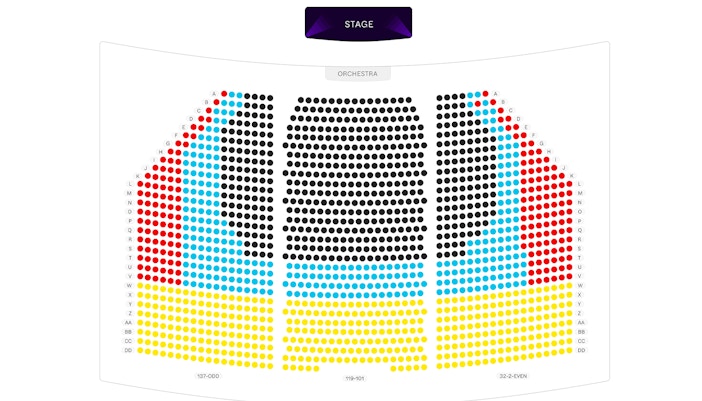
Orchestra
- Total seats: 1,583
- Rows A-EE
- Standing room-only: 100 spots behind the rear rows
- Orchestra Premium Aisle seats are located in the first 20 rows, two on each aisle side, offering excellent views and easy access.
- Orchestra Premium seats occupy the center of the first 20 rows, providing the best views and acoustics. They're flanked by the Orchestra Prime section on the sides and rear.
- Orchestra Front Side seats sit at the far sides of rows C to O, ideal for a side-stage perspective.
- Orchestra Balance seats lie behind and beside the premium areas, offering a well-rounded view.
- Orchestra Rear comprises the last three rows and additional side seating, serving as a budget-friendly option.
- Standing Room is at the rear sides, with no seats, for patrons willing to stand.
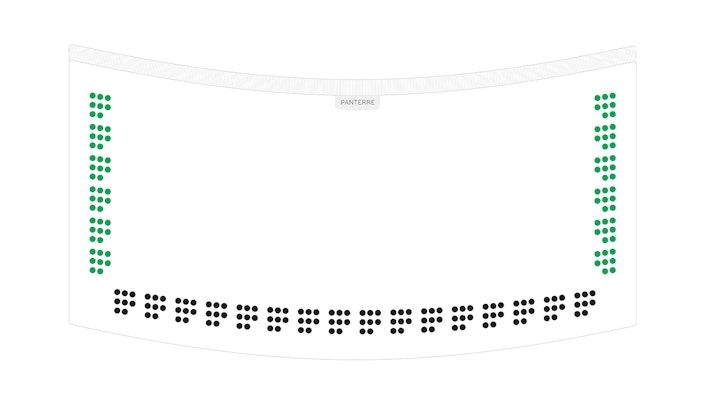
Parterre
- Center boxes (Boxes 13–29): 128 seats
- Side boxes (Boxes 1–12): 92 seats
- The Parterre Center Premium seats are located in the first row of the center, providing unparalleled views and acoustics.
- Just behind them, the Parterre Center seats occupy the second and third rows, still within the prime central viewing area.
- The Parterre Side Box Front seats are in the first row of the side boxes, offering a unique perspective of the stage.
- The Parterre Side Box Rear seats are in the second and third rows of the side boxes.
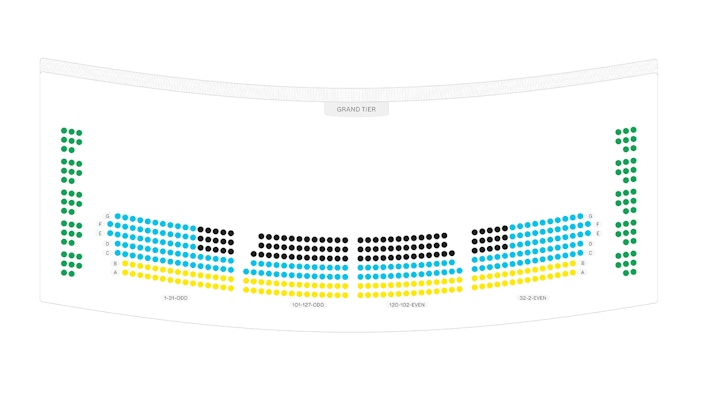
Grand Tier
- Regular seats (Rows A–G): 382
- Side boxes (Boxes 30–39): 60 seats
- Standing room: 30 spots
- The Grand Tier Premium seats are located in the first three rows of the center two sections and a few seats across the aisles.
- The Grand Tier Prime seats occupy rows four and five in the center two sections and rows one through four in the side center sections.
- The Grand Tier Balance seats in rows five and six continue to provide good views while being slightly further back.
- The Grand Tier Box Rear seats, in the back row of the side boxes, provide partial views at a lower price.
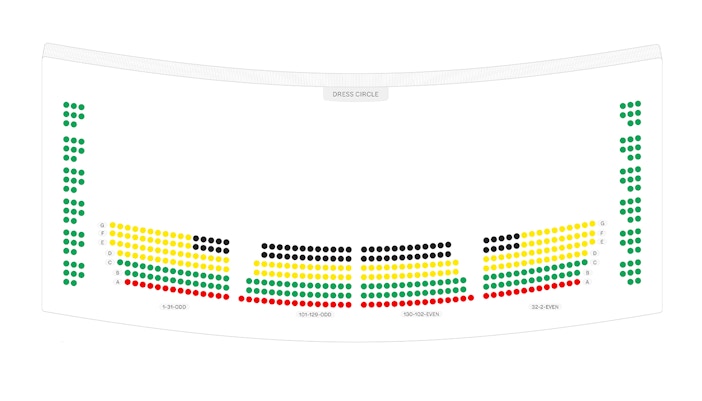
Dress Circle
- Regular seats (Rows A–G): 386
- Side boxes (1–12): 68 seats
- Standing room: 40 spots
- The Dress Circle Premium seats are situated in the first three rows of the center two sections and the first two rows of the side center sections.
- The Dress Circle Prime seats, located in rows four through six in the center two sections.
- The Dress Circle Balance seats are in the seventh row of the center sections and rows four through seven in the side center sections.
- The Dress Circle Boxes along the sides offer partial views and a more intimate setting.
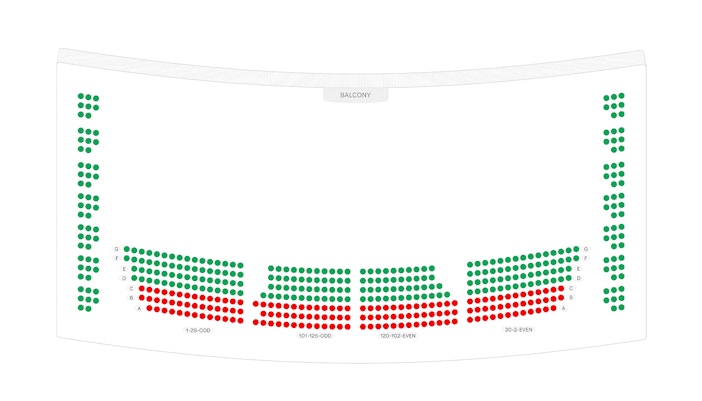
Balcony
- Regular seats (Rows A–G): 362
- Side boxes (1–14): 80 seats
- The Balcony Premium seats are located in the first three rows of the center sections and much of the first three rows of the side center sections.
- The Balcony Prime seats are in rows four through seven of the center sections.
- The Balcony Balance seats occupy rows four through seven in the side center sections.
- The Balcony Boxes along the sides offer partial views, creating a more secluded atmosphere.
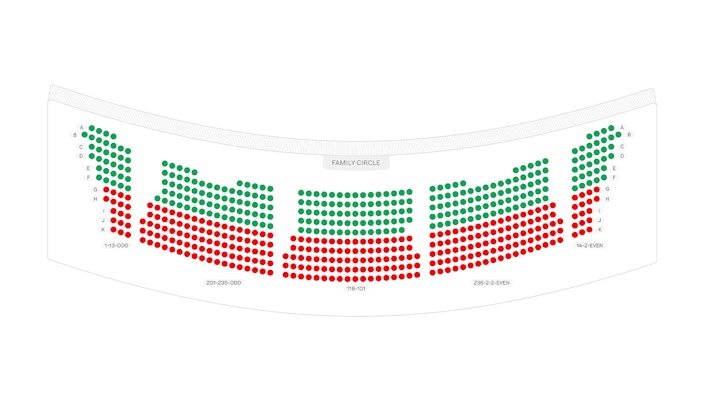
Family Circle
- Regular seats (Rows A–K): 591
- Standing room: 75 spots
- Score Desks (301–324) are not included in the seat count.
- The Family Circle Premium seats are located in rows one through four of the center three sections.
- The Family Circle Prime seats span rows five through eleven in the center.
- The Family Circle Balance seats occupy rows six through eleven in the side sections, offering good value for money. The Family Circle Boxes on the sides have partial views for a more intimate experience.
Value for money seats
- Stalls (Rows E–M): Centrally located with clear, immersive views—these seats offer excellent stage visibility at a lower price than front-row Orchestra or premium boxes.
- Dress Circle (Rows C–F, center): Elevated with a clean sightline and strong acoustics—ideal for appreciating both vocals and staging without the premium cost of Grand Tier or Parterre.
- Orchestra Balance: Positioned behind the premium sections—these offer a centered perspective with solid audio-visual quality at a moderate price point.
- Family Circle (front rows): Farther from the stage but elevated for a complete view—these seats are among the most economical while still providing a good overall opera experience.
Best views of the stage
- Orchestra Premium (Rows C–H, center): Offers unmatched proximity and sightlines—perfect for those who want to feel fully immersed in the performance.
- Parterre Boxes (center): Slightly elevated and close to the stage—these seats provide a luxurious, private viewing experience with excellent acoustics.
- Grand Tier (Rows A–C, center): Elevated for a sweeping, unobstructed view of the entire stage—ideal for appreciating complex staging and visuals.
- Dress Circle (Rows A–C, center): Combines height with nearness, delivering a balanced, top-tier view without the premium pricing of Parterre or Grand Tier boxes.
Frequently asked questions about Metropolitan Opera House seating chart
The best seats at the Metropolitan Opera House are typically found in the Center Orchestra (Rows A–L) and the Grand Tier boxes, which offer excellent sightlines and acoustics. For a premium experience, opt for front-row Grand Tier or Orchestra Center seats.
Wheelchair-accessible seating is available in the Orchestra level of the Met Opera House. Companion seating is provided nearby. Elevators also make it easier to access designated areas in the lower and upper lobby.
For good views at more affordable prices, consider the Rear Orchestra, Dress Circle, or Balcony Front sections. These seats balance sightlines and sound clarity while being less expensive than premium Orchestra or Grand Tier locations.
Yes, the Metropolitan Opera House is fully air-conditioned and climate-controlled, ensuring a comfortable experience for audiences throughout the year.
No, outside food and beverages are not allowed inside the Metropolitan Opera House. However, refreshments are available for purchase at the lobby bars and concession stands during intermissions.
Yes, restrooms are available on all levels of the Metropolitan Opera House. Additional accessible restrooms can be found on the Orchestra and Grand Tier levels.
Yes, assistive listening devices are available upon request.
Yes, children are welcome, but it's advisable to check the specific performance's suitability for younger audiences.
It's recommended to arrive at least 30 minutes before the performance to allow time for seating and any necessary accommodations.
There is no official dress code at the Metropolitan Opera. However, most guests choose to dress in business casual or formal attire, particularly for evening performances and gala events.
The Metropolitan Opera House, commonly known as the Met, was founded in 1883 in New York City. Originally located at 39th Street and Broadway, it became a cultural hub for world-class opera. In 1966, the company moved to its current home at Lincoln Center, where it continues to present globally renowned productions.
The current Metropolitan Opera House at Lincoln Center was completed in 1966, replacing the original building from 1883. The new venue was designed by architect Wallace K. Harrison and is known for its grand archways and iconic Marc Chagall murals.
The Old Metropolitan Opera House was the original venue for the Met, located at 1411 Broadway. It served as the company’s home from 1883 until its closure in 1966. Though grand in design, it became outdated and was eventually demolished.
The Academy of Music was New York's primary opera venue before the Met existed. However, it catered to elite patrons and offered limited accessibility. The Met was founded in response to this exclusivity, offering broader access and grander productions.
The original Met building was demolished in 1967 due to its aging infrastructure and the company's move to the state-of-the-art Lincoln Center facility. The site was replaced by commercial developments in Midtown Manhattan.
Happy customers across 10,000+ experiences
5,000+ verified reviews with 90% excellent score
All the outdoor activities are 100% safe and secure
Have a question? Live chat with local experts anywhere, anytime

